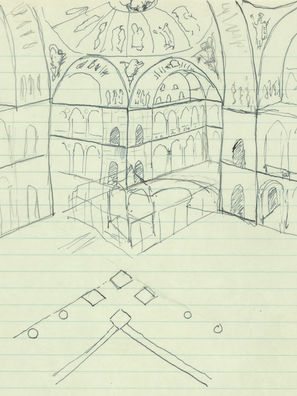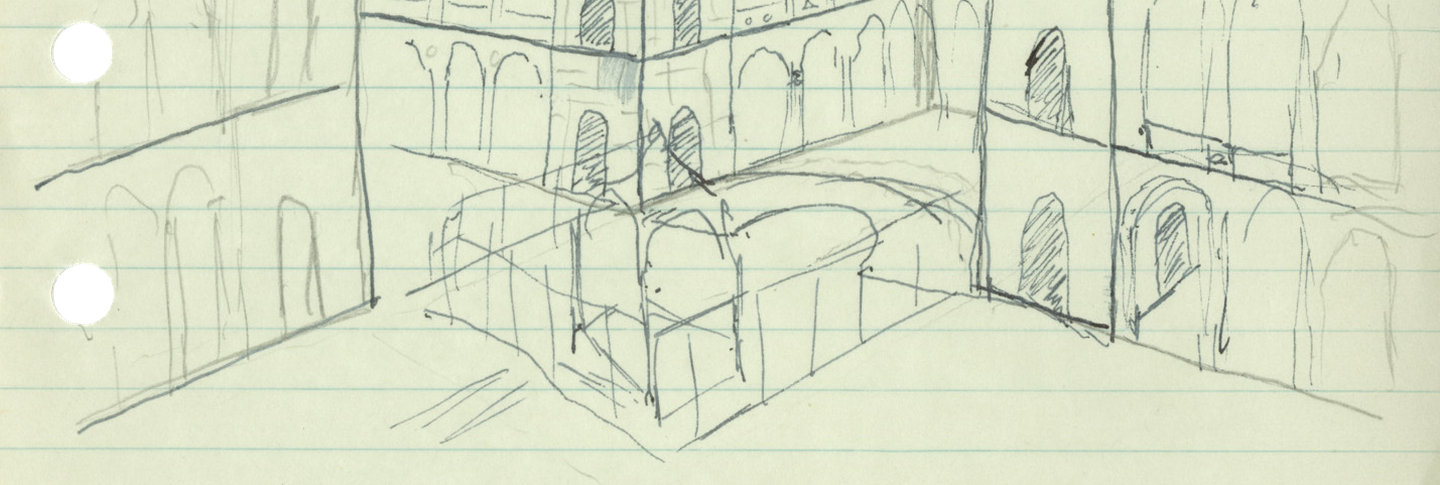
The drawings reproduced in this online exhibition are the outcome of a truly collaborative project in the early years of Dumbarton Oaks. While they were all produced by Underwood, the ideas that made them possible were shared by Underwood, Friend, and Downey. The ultimate goal of the project was a comprehensive three-part publication on the Holy Apostles that would present the architecture, the mosaic decoration, and the relevant texts that describe the monument.
Friend was appointed to be in charge of research at Dumbarton Oaks in 1945. He succeeded Wilhelm Koehler, who had initiated a project to create a catalog of early Christian and Byzantine monuments, and had assigned art historical Junior Fellows to compile visual material and philological Junior Fellows to assemble associated texts. When Friend inherited these projects, referred to as the Research Archive and the Fontes, respectively, he opted to shift to a more focused approach instead of continuing Koehler’s broad scope. He initiated specific projects on the Church of Sion in Jerusalem and the Holy Apostles in Constantinople. As Friend explained in a lecture prepared for the 1947 symposium on Byzantine Art and Scholarship, the projects, “started in war time, have to do with churches which were so completely destroyed in the Middle Ages that the first-hand investigation of the sites, impossible under present conditions, would play but a secondary part in their restoration.”
For the Holy Apostles project, Friend chose to work with Downey and Underwood, two young Junior Fellows at Dumbarton Oaks, originally from Princeton. As part of the Fontes project, Downey had already established a complete textual apparatus for the Holy Apostles. Underwood was brought on board for his training in both architecture and archaeology, but especially because of his draftsmanship. A reconstruction project of this scope seemed feasible only if scholars from three different backgrounds, and with an openness to more than their own specialization, could work together.
The project began as early as 1945. By 1946, a smaller case study had been finalized that would exemplify their approach: a reconstruction drawing of the central dome of the Nea Ekklesia of Basil I (r. 867–886), another important lost Constantinopolitan church, replete with all details of its iconographic program (see p. 40, fig. 22). It was exhibited during the Dumbarton Oaks symposium on Hagia Sophia, in 1946. This drawing was executed by Underwood, based on the description found in the tenth homily of the ninth-century Constantinopolitan patriarch Photios, following Downey’s interpretation of the text and Friend’s understanding of the iconography. The approach was a clear success and paved the way for institutional support of the larger Holy Apostles project.
By the summer of 1947, Downey had completed the majority of the translations and editions of the two most important texts, by the Rhodian and Mesarites. The steady progress of the project and the logical thematic progression from the cathedral of Hagia Sophia to the imperial mausoleum of the Holy Apostles, led Sirarpie Der Nersessian, who was by that time a member of the Board of Scholars, to propose that the next symposium, in 1948, should be devoted to the Holy Apostles.
The papers that Downey, Underwood, and Friend gave during this symposium provide a glimpse of the direction and focus of their project. Downey spoke about the literary evidence and Underwood presented his drawings of the geometry of the space, rendered according to Downey’s translation of the Rhodian, as well as more detailed drawings of the interior and a ground plan of the entire complex based on Mesarites and other sources. His two papers provide a visual tour through the texts and his understanding of them. Friend gave two talks on the mosaics, dating them to the time of Emperor Basil I and detailing their iconography. It is unclear which versions of the dome drawings were shown at this time. Additional papers were given, on ninth-century mosaic decoration by the symposiarch, Der Nersessian, and on the intellectual background, by Francis Dvornik and Milton Anastos.
It is certain that Downey had finalized his translations and editions of both the Rhodian and Mesarites by 1949 and was ready to have them published. Underwood’s manuscript on the architecture was also in an almost final form, but he left the project to succeed Thomas Whittemore as the fieldwork director of the Byzantine Institute, and to continue the conservation and restoration of Hagia Sophia and Kariye Camii in Istanbul. Underwood communicated with Friend, who continued work on his part of the project, and he sent sketches of different versions of the mosaic decoration of the domes. Friend presented the project a few more times in the early 1950s, but he had not finished his volume of the planned joint publication when he died, in 1956. Downey eventually managed to publish Mesarites’ text in 1957, and Underwood saw his drawing of the Nea Ekklesia dome materialized through the mosaic decoration in the newly built Saint Sophia Cathedral in Washington, D.C.
When Underwood died in 1968, the possibility of publishing the results of the project, begun more than two decades earlier, was ultimately dismissed by the publications committee of Dumbarton Oaks. Underwood’s meticulously executed drawings synthesized the knowledge and ideas of all three scholars, but never received the attention they clearly deserved.
Exhibit Items
Sketch from a notebook by Albert M. Friend. MS.BZ.019-03-01-054.
Notes by Albert M. Friend. MS.BZ.019-03-02-068.
Notes and sketches from a notebook by Albert M. Friend, Spring 1948. MS.BZ.019-03-02-066.
Sketch from a notebook by Albert M. Friend. MS.BZ.019-03-02-063.
Photographs from Albert M. Friend’s research material. MS.BZ.019-03-01-054.
Photograph from Albert M. Friend’s research material. MS.BZ.019-03-01-049.
Reproduction of a preparatory sketch by Paul A. Underwood. MS.BZ.019-03-01-057.
MS.BZ.019-03-02-071
Translation by Glanville Downey. MS.BZ.018.
Conference paper by Paul A. Underwood. MS.BZ.019-03-01-050.









